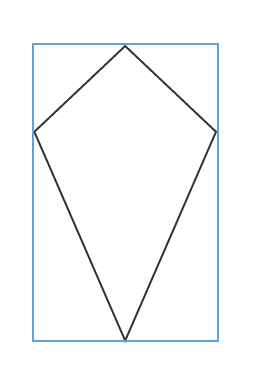All SAT II Math I Resources
Example Questions
Example Question #31 : 2 Dimensional Geometry

Note: Figure NOT drawn to scale.
Refer to the above diagram. Evaluate the length of the hypotenuse of the blue triangle.
The inscribed rectangle is a 20 by 20 square. Since opposite sides of the square are parallel, the corresponding angles of the two smaller right triangles are congruent; therefore, the two triangles are similar and, by definition, their sides are in proportion.
The small top triangle has legs 10 and 20. Therefore, the length of its hypotenuse can be determined using the Pythagorean Theorem:
The small top triangle has short leg 10 and hypotenuse 


Example Question #31 : 2 Dimensional Geometry

Note: figure NOT drawn to scale.
Refer to the triangle in the above diagram.

Evaluate 
By the Law of Sines,
Substitute 

Example Question #1 : Finding Sides

Note: figure NOT drawn to scale.
Refer to the triangle in the above diagram.
Evaluate 
By the Law of Cosines,
Substitute 
Example Question #2 : Finding Sides

The above figure is a regular pentagon. Evaluate 
Two sides of the triangle formed measure 4 each; the included angle is one angle of the regular pentagon, which measures
The length of the third side can be found by applying the Law of Cosines:
where 
Example Question #41 : Geometry
In triangle 


Which of the following statements is true about the lengths of the sides of 
In a triangle, the shortest side is opposite the angle of least measure; the longest side is opposite the angle of greatest measure. Therefore, if we order the angles, we can order their opposite sides similarly.
Since the measures of the three interior angles of a triangle must total 






Example Question #41 : Geometry
Which of the following describes a triangle with sides one kilometer, 100 meters, and 100 meters?
The triangle is acute and isosceles, but not equilateral.
The triangle is acute and equilateral.
The triangle is obtuse and isosceles, but not equilateral.
The triangle is obtuse and scalene.
The triangle cannot exist.
The triangle cannot exist.
One kilometer is equal to 1,000 meters, so the triangle has sides of length 100, 100, and 1,000. However,
That is, the sum of the least two sidelengths is not greater than the third. This violates the Triangle Inequality, and this triangle cannot exist.
Example Question #3 : Finding Sides

Note: Figure NOT drawn to scale.
Refer to the above diagram. Evaluate 
The correct answer is not among the other responses.
The correct answer is not among the other responses.
The altitude perpendicular to the hypotenuse of a right triangle divides that triangle into two smaller triangles similar to each other and the large triangle. Therefore, the sides are in proportion. The hypotenuse of the triangle is equal to
Therefore, we can set up, and solve for 
This is not one of the choices.
Example Question #41 : Geometry
What is the sum of three sides of a square if the fourth side has a length of 
All of the sides of a square have the same length.
That means all four sides of this square have a length of 
The sum of three of them would then be

Example Question #1 : How To Find The Length Of The Diagonal Of A Kite

The area of the rectangle is 
The area of a kite is half the product of the diagonals.
The diagonals of the kite are the height and width of the rectangle it is superimposed in, and we know that because the area of a rectangle is base times height.
Therefore our equation becomes:

We also know the area of the rectangle is 
Thus,, the area of the kite is 
Example Question #11 : Kites

Using the kite shown above, find the length of the red (vertical) diagonal.
In order to solve this problem, first observe that the red diagonal line divides the kite into two triangles that each have side lengths of 



The solution is:
Certified Tutor
All SAT II Math I Resources










































![m = \left [\frac{180(5-2)}{5} \right ] ^{\circ }= 108^{\circ }](https://vt-vtwa-assets.varsitytutors.com/vt-vtwa/uploads/formula_image/image/216649/gif.latex)















































